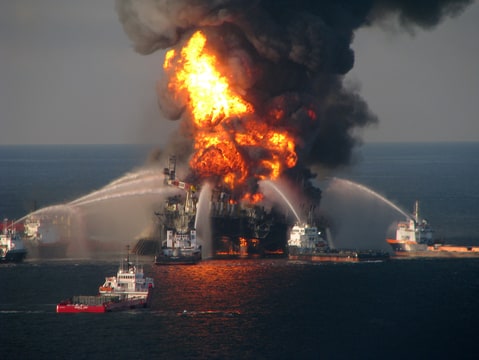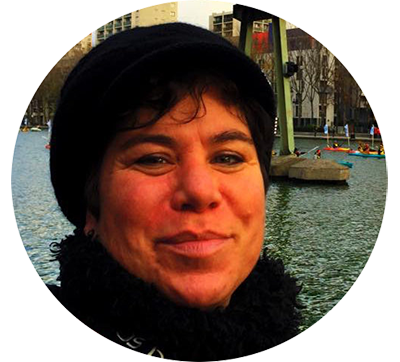6 Years After Gulf Oil Spill, Residents Demand ‘No More Drilling.’

 Watch the Rolling Stone video for Antonia’s article here.
Watch the Rolling Stone video for Antonia’s article here.
On March 23rd, weeks before the sixth anniversary of the BP oil spill, hundreds of protesters march into the New Orleans Superdome carrying banners reading “Keep It In the Ground,” “No More Drilling” and “No New Leases.” Hurricane Katrina made the Superdome an icon of climate destruction and government ineptitude, but on this day, the Interior Department has made it the location of a federal auction for 45 million acres in the offshore Gulf of Mexico for new oil and gas drilling.
Less than two weeks later, Louisiana Federal District Judge Carl Barbier accepted a final settlement agreement between BP, the federal government, five states and hundreds of local governments, bringing to an end the feds’ six-year case against BP and most major outstanding legal cases against the company stemming from the April 20, 2010, Macondo well blowout and the worst offshore drilling oil spill in history.
At $20 billion, it is the largest environmental settlement in U.S. history, and the largest civil settlement with a single entity ever. Nonetheless, as Rolling Stone previously reported, BP got off cheaply with the deal, while decisions made as part of the legal process made offshore oil drilling more dangerous.
The final criminal case against BP and Halliburton employees stemming from the disaster was also heard this month. Federal prosecutors originally sought criminal charges, including manslaughter. In the end, all they achieved were acquittals or plea bargains for lesser offenses that resulted in no prison time for any of the five men charged (the most senior among them a BP vice president), with the final case ending in a misdemeanor charge and probation.
Industry and government have learned crucial lessons from the blowout at BP’s Macondo well, the explosion of the Deepwater Horizon rig, the deaths of 11 men and the release of millions of gallons of oil into the Gulf. Few of those lessons, however, have been acted upon. Instead, it is “business as usual” in offshore drilling, argues David Pritchard, a petroleum engineer who consults for major oil companies, including BP, Mobil, Chevron and Halliburton.

Related article: “BP ‘Got Off Cheaply’ With $18.7 Billion Settlement” by Antonia Juhasz (Adrian Dennis/AFP)
The Department of the Interior has sought to improve offshore drilling safety over the last six years, including over 500 pages of new rules released just last week. Experts warn, however, that these efforts remain woefully insufficient, particularly as companies move to even riskier deeper depths, with 86 percent of new oil production in the Gulf taking place 1,000 to nearly 5,000 feet deeper than BP was drilling the Macondo, including two projects at depths nearly twice as great.
“Are the new guidelines enough to prevent another Macondo disaster?” asks Robert Bea, a 60-year oil-industry veteran and head of the Deepwater Horizon Study Group at the Center for Catastrophic Risk Management, which contributed analysis to the National Oil Spill Commission. “No! They did not address the key factors at its roots.”
In its final and most damning report on the BP disaster, the U.S. Chemical Safety Board, or CSB, an independent federal agency that investigates industrial accidents, warned last week, “Offshore regulatory changes made thus far… do not do enough to prevent another disaster like the Deepwater Horizon rig explosion and oil spill at the Macondo well in the Gulf of Mexico…. [A] culture of minimal regulatory compliance continues to exist in the Gulf of Mexico and risk reduction continues to prove elusive.”
CSB investigator Mary Beth Mulcahy said on Saturday that the new regulations, released the day after the CSB report, are a positive change, but more is needed, most critically on enforcement. Companies are not being required to “put into practice what they put on paper,” she explains. “BP and Transocean had many corporate policies in place before Macondo that would have satisfied these new regulations,” but nobody was “checking to see if they were doing what they said they would do” — or, some would add, if they were even capable of doing so.
Nonetheless, Exxon Mobil has already argued that the new regulations are prohibitively expensive. “Many in our industry view regulations as simply unneeded paperwork,” Pritchard, the petroleum engineer, says, also warning that industry technology is not keeping pace with operations.
As the risks grow, so too do insight into the ongoing environmental harms to the Gulf. The final environmental damage assessment prepared by scores of scientists, four federal and more than a dozen state agencies was released in February detailing millions of wildlife deaths and widespread ecosystem destruction. Its release makes available scientific studies previously kept from public view, including a report attributing a sharp rise in stillborn and infant deaths of bottlenose dolphins to the spill. Recovery of some dolphin populations could take more than 50 years, while some 30 million gallons of BP oil that remain in Gulf waters may bring new harms for thousands of years to come.
For BP, the final financial tally is around $55 billion, an amount below the predictions of analysts at Moody’s rating agency, who in 2011 estimated a total cost to BP of $60 billion. BP called the costs “manageable.” BP remains a leading offshore operator around the world, including in the Gulf of Mexico, bidding on $18 million worth of new leases on March 23rd at the Superdome.

Earlier this month, a federal district judge accepted a final settlement agreement between BP, the federal government, five states and hundreds of local governments. (Oli Scarff/Getty Images)
Nonetheless, BP has suffered a massive 91 percent decline in profits in the fourth quarter of this year and has lain off thousands of workers. BP’s recent losses have more do with the collapse of oil prices than fallout from the Gulf oil spill, though both events have a similar origin: oil companies seeking – and governments allowing – drilling to occur virtually unabated everywhere. The companies are reaping what they have sown: oversupply and unmitigated risk.
The American public has taken notice, with support for offshore drilling falling from 68 percent before the BP disaster to 52 percent today. Even more striking, nearly 75 percent of Americans polled now prefer alternative energy to gas and oil production as the solution to the nation’s energy problems, the highest percentage since at least 2011. Among the presidential candidates, Bernie Sanders has likely gone the farthest in addressing these concerns, co-sponsoring legislation to halt all new fossil fuel leasing in federal waters and public lands.
Which brings us to perhaps the greatest change in the last six years: opposition to offshore oil drilling in the Gulf.
Among the protesters who swarm the Superdome in March are 22-year-old Howard Johnson, who took the bus from Gulfport, Mississippi. Howard had never imagined participating in such an event until his mother became ill after working to clean BP’s oil off of beaches. She has since died. The Reverend James Caldwell travelled from Houston to oppose the “exploitation of the Gulf,” including of his parishioners, from offshore drilling. Monique Verdin, a Native American Houma, never again wants to see her home in St. Bernard Parish buried beneath 11 feet of water, as it was during Hurricane Katrina.
Native Louisianan Cherri Foytlin‘s biggest fear hours earlier was that no one would join the protest. Instead, she beams with satisfaction. “Nothing like this has ever happened here,” she says, as she and other protesters overtake the stage chanting, “It’s not for sale, get off it, the Gulf is not for profit!” Foytlin leans over and tells the government auctioneer, “I need you to go back to the president” and tell him “this is the beginning.”
